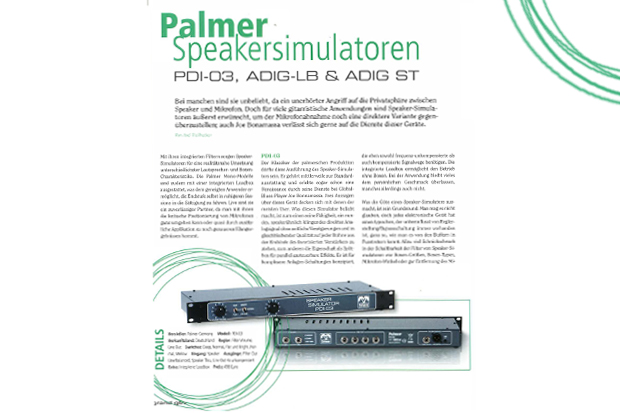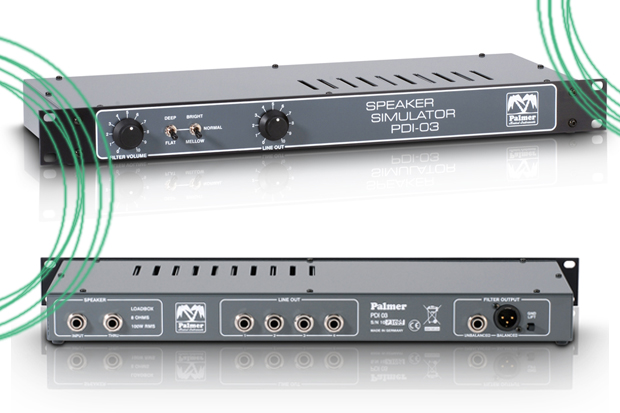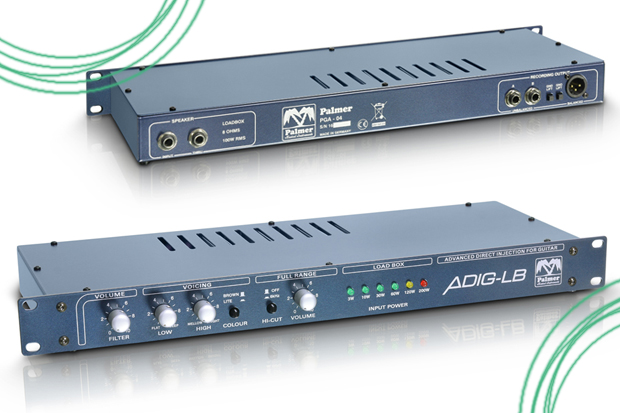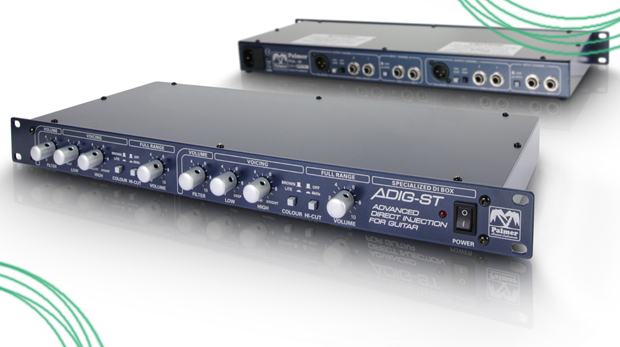Palmer Speaker Simulators PDI-03, ADIG LB & ADIG ST – Test report by grand gtrs
For some, they are unpopular, as they might be considered an outrageous invasion of privacy between speaker and microphone. However, for many guitar applications, speaker simulators are highly desirable as a more direct alternative to miking; even Joe Bonamassa relies on the services provided by these devices.  With their built-in filters, speaker simulators provide a realistic interpretation of various loudspeaker and cabinet characteristics. The Palmer mono models are also equipped with an integrated load box which allows the user to push the power amplifier to the fullest even in quieter sessions. They are a reliable partner for live performances, because with them, you can bypass the critical positioning of microphones or practically achieve more accurate sound results with additional applications.
With their built-in filters, speaker simulators provide a realistic interpretation of various loudspeaker and cabinet characteristics. The Palmer mono models are also equipped with an integrated load box which allows the user to push the power amplifier to the fullest even in quieter sessions. They are a reliable partner for live performances, because with them, you can bypass the critical positioning of microphones or practically achieve more accurate sound results with additional applications.
PDI-03
The classic in the Palmer production range is likely to be this version of the speaker simulator. It is now part of the standard equipment for all musicians. It even experienced quite a renaissance thanks to Global Blues player Joe Bonnamassa. Joe’s feedback about this device is consistent with that of most users. What makes this simulator so popular is: firstly its ability to provide a round, speaker-similar, direct analogue signal without delays and with consistent quality on any stage from the power amp of your favourite amplifier; and secondly, its property as splitbox for parallel controllable effects. It is designed for complex equipment circuits which need both frequency compensated and uncompensated signal paths.
The integrated load box allows operation without speakers. When using the device, much is left to personal taste, but some things are not. It is its basic sound that accounts for the quality of a speaker simulator: you may not believe it, but every electronic device has a typical basic sound which is unaffected by slider/bypass position and is always present, just like with buffers in foot pedals. Too many frills and options in the switching abilities of speaker simulators like speaker sizes, cabinet types, microphone angles or even distance between the microphone and the cabinet do not make the basic sound any better, in my opinion, but are rather euphemistic or are the result of compromises. In this respect, the PDI-03 provides a good sound.  The uncompensated line-outs and the electronically processed signals sound enjoyably open. The provided device is designed for 16 ohms at 100 watts (also available as 2, 4 and 8 ohm versions from Palmer) and of course offers a transfer to speakers. Thus, you can combine the simulated direct signal from the speakers with the microphone signal. You can achieve the optimum sound in the mix, as in the production of speaker compressions, the simulation output stays fairly neutral. This offers opportunities for further signal processing or just a reason to refine mixes of real microphone signals and simulations. The four line-outs, adjustable on the front panel, are used to direct the signal to amp effects specifically on the uncompensated level.
The uncompensated line-outs and the electronically processed signals sound enjoyably open. The provided device is designed for 16 ohms at 100 watts (also available as 2, 4 and 8 ohm versions from Palmer) and of course offers a transfer to speakers. Thus, you can combine the simulated direct signal from the speakers with the microphone signal. You can achieve the optimum sound in the mix, as in the production of speaker compressions, the simulation output stays fairly neutral. This offers opportunities for further signal processing or just a reason to refine mixes of real microphone signals and simulations. The four line-outs, adjustable on the front panel, are used to direct the signal to amp effects specifically on the uncompensated level.
Here the idea has been put into practice to combine a mono signal isolated from effects with two additional effects channels “lt’s playtime!” I have confined myself primarily to the simulation for recording purposes. So I could once again hear the sounds of one or the other amp through my best-sounding Yamaha NS10 (studio monitors) and fiddle around with the switches on the PDI-03. The left toggle switch simulates the speaker/cabinet characteristic between “open 2×12″ combo”, “closed 4xl2″ box (with typical bass)” and “stack with V-shaped EQ position”. The right-hand switch operates the lifting and lowering of the highs, also with three positions: Bright, Normal and Mellow. I stayed away from the left switch and selected, as a standard, the centre position labelled “Normal”. The lowering of highs was also out of the question for me, I only occasionally switched from “Normal” to “Bright”.
My various Marshalls felt very comfortable with this. I found it more convenient to leave the amp in the mid-level and to involve the pre-amplifier distortion with an appropriate booster. The use of an EQ mixer console, outboard gear or plug-ins on the digital level is easily possible thanks to the open sound of the PDI. Here, it’s worth it, at least for lead sounds, in order to help the signal in the mid frequencies and to add some compression if necessary. Unless you mix in an alternative microphone, as already mentioned. This is then really good, because you just tune the channels until the appropriate phase is found, and so the use of extra sound processors is kept to a minimum.
For live performances, the Palmer PDI-03 is a safe bet, because it is very pleasant soundwise, so that engineers mostly prefer to use it when given the choice of the channel selection.
Manufacturer: Palmer Germany
Model: PDI03
Country of Origin: Germany
Controllers: Filter-Volume, Line Out
Switches: Deep, Normal, Flat and Bright, Normal, Mellow
Input: Speaker
Outputs: Filter Out Line/Balanced, Speaker Thru, Line Out 4x uncompensated
Bonus: Integrated Loadbox
Price: € 498
Click here for more information about this product:
http://www.palmer-germany.com/mi/en/PDI-03-Speaker-Simulator-with-Loadbox-8-ohms-PDI03.htm
ADIG-LB (speaker simulator with load box PGA04)
The step up from the PDI-03 is probably the ADIG-LB in the Palmer range, which is a more complex device in terms of sound modulation capacity. The idea of miscibility of different-sound signals is performed in the device itself. Using a controller, you can now mix the uncompensated signal with the simulated speaker and tap it at the output. In addition, there is now a “Colour” switch (Lite/Brown) for voicing and continuously variable controls for treble and bass of the filtered channel as well as attenuation of the highs for the unfiltered channel. An LED meter shows the output level of the amp – It does not get more practical than that! However, the four-effect line-outs have ceased to exist, after all, what are alternative splitters for? It is clear that the handling of this model is absolutely practical and provides maximum sound variability. What is delivered here in terms of sonic possibilities is genuinely useful; however, personally, I preferred the basic sound of the PDI-03. For me, it’s better in terms of the open directness of the signal over the entire frequency range.  The ADIG-LB (Advanced Direct Injection For Guitar) sounds, however, somewhat compressed, but not really attenuated in the highs or with too little bass. rand gtrs When mixing a production, it is crucial. As far as speaker simulation assertiveness and the thus restricted dynamics of the signal are concerned, the breathy sound is less pronounced when comparing both models. This is of course due to the already self-imposed standards of Palmer and suits my personal taste.
The ADIG-LB (Advanced Direct Injection For Guitar) sounds, however, somewhat compressed, but not really attenuated in the highs or with too little bass. rand gtrs When mixing a production, it is crucial. As far as speaker simulation assertiveness and the thus restricted dynamics of the signal are concerned, the breathy sound is less pronounced when comparing both models. This is of course due to the already self-imposed standards of Palmer and suits my personal taste.
Manufacturer: Palmer Germany
Model: PGA04
Country of Origin: Germany
Controllers: Filter Volume, Full Range Volume, Voicing (Bass/Treble)
Switches: Lite/Brown (filter-Channel), Hi Cut (6.5 kHz)
Input: Speaker
Outputs: Filter Out Line/Balanced, Speaker Thru, Line Out 4x uncompensated
Bonus: Integrated Loadbox
Price: € 528
Click here for more information about this product:
http://www.palmer-germany.com/mi/en/PGA-04-Speaker-Simulator-with-Loadbox-8-Ohms-PGA04.htm
ADIG-ST (Stereo DI Box Speaker Simulator PGA05)
This model is initially identical in the structure of the tone control. You might think it was a stereo version of the ADIG-LB. While it processes power amp signals, it does not have a load box, so that you have to either use speakers in parallel or connect to an external load box when muting the signal. The ADIG-ST does not offer a power reduction as a link between the amplifier and speaker. However, what this simulator enables is the processing of line-level signals. Here you can upstream other processors, guitar preamps to the line level. So, for example, when I tap my YJM-Marshall (Malmsteen Signature Top) via additional speaker attenuation line-out, work with a tube EQ or compressor, and then direct it to the ADIG-ST for speaker compensation, it works well and gives a superb sound, which sounds better in comparison to the loss of momentum that I have just mentioned with the ADIG-LB. I have more control before the signal arrives in the simulator, and so achieve a better match.  As is often the case, this version is best suited for compact guitar processors. Thanks to its deliberate stereo design, which allows for separate controllability of the channels and can be used in double mono applications, the ADIG-ST can also be used simultaneously with an amp signal and as a filter section when using another signal path, for example. You could of course also work with two different amps in different ways within two “looped” circuits. It’s a pity that there is not enough room in the housing for two load boxes. By the way, this device requires a power supply, as opposed to the other two which are completely passive.
As is often the case, this version is best suited for compact guitar processors. Thanks to its deliberate stereo design, which allows for separate controllability of the channels and can be used in double mono applications, the ADIG-ST can also be used simultaneously with an amp signal and as a filter section when using another signal path, for example. You could of course also work with two different amps in different ways within two “looped” circuits. It’s a pity that there is not enough room in the housing for two load boxes. By the way, this device requires a power supply, as opposed to the other two which are completely passive.
Manufacturer: Palmer Germany
Model: PGA05
Country of origin: Germany
Controllers: Filter Volume, Full Range Volume, Voicing (Bass / Treble)
Switches: Lite / Brown (filter-Channel), Hi Cut (6.5 kHz)
Input: Speaker/line (switchable)
Outputs: Filter Out Line/Balanced, Speaker Thru, Line Out 4x uncompensated
Bonus: Stereo designed, no Loadbox
Price: € 792
Click here for more information about this product:
http://www.palmer-germany.com/mi/en/PGA-05-Stereo-DI-Box-Speaker-Simulator-PGA05.htm
Conclusion
For sound purists, the PDI-03 is still a top notch device for covering everything related to power reduction, simulation and recording in a simple manner. The other devices are brilliant in their concept and in terms of the sound variations, and are actually superior to the PDI, however in comparison to the predecessor PDI-03, the base sound is different. You should try out different models, because personal taste is crucial and the Palmer simulators are completely open to any peripherals. If you’re not playing Blues, but have rather been infected with Hi-Gain and Low-Bottom or even value different music styles and soundscapes, the ADIG control options are probably better for you. In a studio, the stereo version is likely to be a real asset.
For more information about Palmer, go to: http://www.palmer-germany.com/mi/en.htm
Source: grand grts, Germany
Author: Axel Heilhecker
Leave a Comment
You must be logged in to post a comment.











